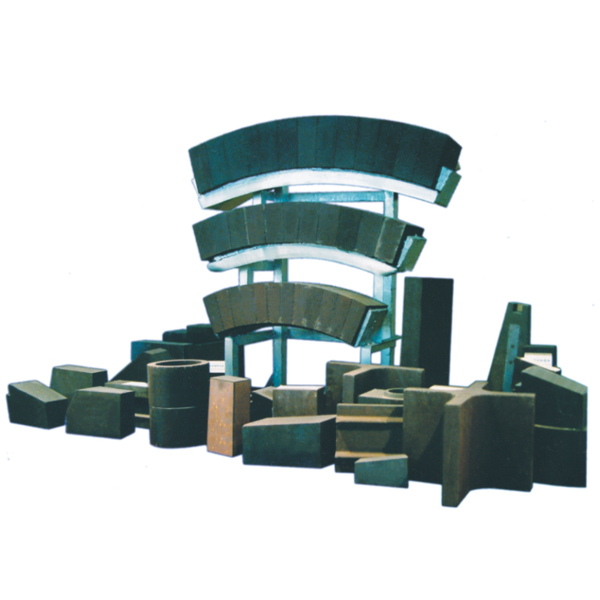Contact: Lin Manager
Mobile phone: 182-4265-7979
Landline (fax): 0417-5845558
Website: www..csnh10.com
en.csnh10.com
Address: Nanlou Economic Development Zone, Yingkou City, Liaoning Province
Among ordinary and special heat storage brick refractories, the commonly used varieties mainly include the following electric furnace magnesia carbon bricks
Acidic
Silica bricks and clay bricks are used in larger amounts. Silica bricks are siliceous products containing more than 93% SiO2. The raw materials used are silica and waste silica bricks. Silica bricks have strong resistance to acid slag erosion, but are susceptible to alkaline slag. Its load softening temperature is very high, close to its refractoriness. After repeated calcination, the volume does not shrink or even slightly expands, but it is resistant to
Poor thermal shock. Silica bricks are mainly used in thermal equipment such as coke ovens, glass melting furnaces, and acid steel furnaces. Clay bricks contain 30%~46% alumina. It uses refractory clay as the main raw material. It has a refractoriness of 1580~1770℃ and good thermal shock resistance. It is a weak acid refractory material and has corrosion resistance to acid slag. It has a wide range of uses. It is a type of refractory with large production volume.

neutral
The main crystal phases in high-alumina products are mullite and corundum. The content of corundum increases with the increase of alumina content. Corundum products containing more than 95% alumina are a kind of refractory materials with wide application. Chrome bricks are mainly made of chrome ore, and the main crystal phase is chromite. It has good corrosion resistance to steel slag, but poor thermal shock resistance and low deformation temperature under high temperature load. Chrome magnesia bricks made of chrome ore and magnesia in different proportions have good thermal shock resistance and are mainly used as alkaline open-hearth roof bricks.
Magnesia brick
Carbon products are another type of neutral refractory materials. According to the composition of carbon-containing raw materials and the mineral composition of the products, they are divided into three categories: carbon bricks, graphite products and silicon carbide products. Carbon bricks are made of high-grade petroleum coke as raw materials, adding tar and pitch as binders, and sintering at 1300°C without air. The carbon material for graphite products is made by graphitizing treatment at 2500-2800°C in an electric furnace. Silicon carbide products use silicon carbide as raw material, add clay, silicon oxide and other binders to sinter at 1350 to 1400°C. Silicon carbide and silicon powder can also be made into silicon nitride-silicon carbide products under nitrogen atmosphere in an electric furnace.
Carbon products have very low thermal expansion coefficient, high thermal conductivity, good thermal shock resistance and high high temperature strength. It does not soften after long-term use at high temperature, is not corroded by any acid and alkali, has good salt resistance, and is not wetted by metals and slag. It is light in weight and is a high temperature resistant material. The disadvantage is that it is easy to oxidize at high temperature and is not suitable for use in an oxidizing atmosphere. Carbon products are widely used in high-temperature furnace linings (furnace bottom, hearth, lower part of the furnace shaft, etc.) and linings of non-ferrous metal smelting furnaces. Graphite products can be used to line reaction tanks and petrochemical autoclaves. Silicon carbide and graphite products can also be made into crucibles for melting copper, gold and light alloys.
Alkaline
Represented by magnesium products. It contains more than 80%-85% of magnesium oxide, with periclase as the main crystal phase. The main raw materials for the production of magnesia bricks are magnesite, seawater magnesia, and calcination of magnesium hydroxide extracted from seawater at high temperature). It has good resistance to alkaline slag and iron slag. The melting point of pure magnesia is as high as 2800℃. Therefore, the fire resistance of magnesia bricks is higher than that of clay bricks and silica bricks. Since the mid-1950s, due to the adoption of oxygen-blown converter steelmaking and the use of alkaline open hearth furnace tops, the production of alkaline refractories has gradually increased, while the production of clay bricks and silica bricks has decreased. Alkaline refractories are mainly used in open hearth furnaces, oxygen blowing converters, electric furnaces, non-ferrous metal smelting and some high-temperature thermal equipment.
Contact: Manager Lin Electric Furnace Magnesia Carbon Brick
Mobile phone: 182-4265-7979
Website: www.csnh10.com
Address: Chenjia Village, Nanlou Economic Development Zone, Yingkou City, Liaoning Province

Scan to learn more